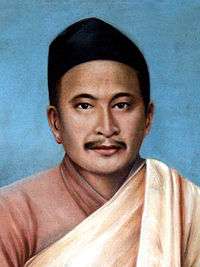Nisthananda Bajracharya
Nisthananda Bajracharya (Devanagari: निष्ठानन्द बज्राचार्य) (9 December 1858 – 29 November 1935) was a Nepalese author who marked a turning point in Nepal Bhasa literature by breaking away from the classical style and writing prose in colloquial language.[1] He was one of the leaders of the Nepal Bhasa renaissance,[2] and also a pioneer of printing with moveable type in Nepal.[3] He is honored as one of the Four Pillars of Nepal Bhasa.
Nisthananda Bajracharya | |
|---|---|
 Portrait of Nisthananda Bajracharya | |
| Born | December 9, 1858 Om Bahal, Kathmandu |
| Died | November 29, 1935 (aged 76) |
| Language | Nepal Bhasa |
| Literary movement | Nepal Bhasa renaissance |

Early life
Bajracharya was born in Om Bahal, Kathmandu to father Muktananda and mother Thakumati Bajracharya. He belonged to a family of hereditary Newar Buddhist priests, who engaged in performing sacred rituals. His first wife Ratna Prabha died in 1901, and he subsequently married Dyah Mayju.
Career
In 1901, after completing Buddhist studies, Bajracharya began giving religious discourses. His storytelling sessions were held in sacred courtyards and other open spaces and lasted four months. Bajracharya had a clear style of narrating stories which made him greatly popular. He adapted the ancient texts into easy-to-understand everyday language, as the old writing style had become complex to listeners.
The written and spoken forms of Nepal Bhasa had begun to grow apart as its development came to an end around 1850 with the advent of the Rana dynasty. The Ranas did not like Nepal Bhasa and suppressed its use.[4] By the time literary activities were revived during the Nepal Bhasa renaissance,[5] the old style of writing had become difficult to follow. Bajracharya modernized the language by discarding the traditional spelling rules and writing it as it was spoken. He also brought a new style into prose writing by simplifying sentence construction.[6]
Publications
In 1909, Bajracharya published Ek Bishanti Prajnaparamita, the first book in Nepal Bhasa to be printed with moveable type. Lalita Vistara, his most famous work which is based on the Buddha's life story,[7][8] and Swayambhu Purana were published in 1914.[9] Bajracharya travelled to Kolkata, India to procure letterpress type as printing facilities were not available in Kathmandu. He did the typesetting and printing himself. Lalita Vistara also contributed to the revival of Buddhism in the 1920s.[10]
Legacy
A bust of Bajracharya was erected at his birthplace Om Bahal, Kathmandu on 23 November 1998 by Olympus Club (Nisthananda Memorial Trust).[11] A street in central Kathmandu was named Nisthananda Marg in his honor by Kathmandu Metropolitan City.[12]
References
- Hridaya, Chittadhar (1982, third ed). Jheegu Sahitya ("Our Literature"). Kathmandu: Nepal Bhasa Parishad. Pages 25-36.
- "Contributions to Nepalese Studies, Volume 22". Institute of Nepal and Asian Studies, Tribhuvan University. 1995. Missing or empty
|url=(help) Page 74. - M, Razen (November 2011). "Pioneer of Nepalbhasha printing", The Newarland. Page 8.
- Lienhard, Siegfried (1992). Songs of Nepal: An Anthology of Nevar Folksongs and Hymns. New Delhi: Motilal Banarsidas. ISBN 81-208-0963-7. Page 1.
- Gellner, David N. "Language, Caste, Religion and Territory: Newar Identity Ancient and Modern". Retrieved 29 December 2011. Page 128.
- Sudarshan, Bhikshu (1970). Lumanke Bahahpin ("Memorable Figures"). Kathmandu: Chwasa Pasa. Pages 1-5.
- LeVine, Sarah and Gellner, David N. (2005) Rebuilding Buddhism: The Theravada Movement in Twentieth-Century Nepal. Harvard University Press. ISBN 978-0-674-01908-9. Page 258. Retrieved 25 December 2011.
- Gellner, David N. "Language, Caste, Religion and Territory: Newar Identity Ancient and Modern". Retrieved 29 December 2011. Page 129.
- Shakya, Bajra Raj & Bajracharya, Shanta Harsa (1993). "Newar Buddhist Culture: A Concept". Retrieved 26 December 2011.
- Gellner, David N. (2008). "Gyanmala Bhajan (Devotional songs)". Lumbini Nepalese Buddha Dharma Society (UK). Archived from the original on 19 March 2012. Retrieved 29 December 2011.
- Nepal Ritu Pau, Vol. 47 No. 88 (1998). Kathmandu: Nepal Bhasa Parisad. Page 2.
- "Addressed Road Network Map". Kathmandu Metropolitan City. Archived from the original on March 6, 2012. Retrieved 25 December 2011.